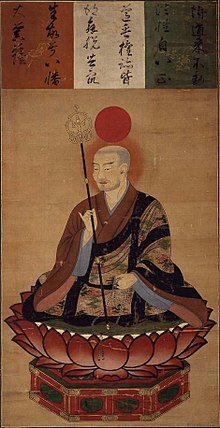Hachiman

In Japanese mythology, Hachiman (八幡神, Hachiman-jin/Yahata no kami) is the Japanese syncretic god of archery and war,[1][2][3] incorporating elements from both Shinto and Buddhism.[4] Although often called the god of war, he is more correctly defined as the tutelary god of warriors.[4][5] He is also divine protector of Japan and the Japanese people. Therefore, Imperial house, Genji (Minamoto clan) and most samurai worship him. The name means "God of Eight Banners", referring to the eight heavenly banners that signaled the birth of the divine Emperor Ōjin. His symbolic animal and messenger is the dove.
Since ancient times Hachiman was worshiped by peasants as the god of agriculture and by fishermen who hoped he would fill their nets with much fish. In the Shinto religion, he became identified by legend as the Emperor Ōjin, son of Empress Consort Jingū, from the 3rd – 4th century AD.
Syncretism

After the arrival of Buddhism in Japan, Hachiman became a syncretistic deity, fusing elements of the native kami worship with Buddhism (shinbutsu shūgō). In the Buddhist pantheon in 8th century AD, he became Hachiman Great Bodhisattva (八幡大菩薩, Hachiman Daibosatsu).[6]
Samurai worship
Because as Emperor Ōjin he was an ancestor of the Minamoto clan, Hachiman became the tutelary kami (氏神, ujigami) of the Minamoto samurai clan.[5] Minamoto no Yoshiie, upon coming of age at Iwashimizu Shrine in Kyoto, took the name Hachiman Taro Yoshiie and through his military prowess and virtue as a leader, became regarded and respected as the ideal samurai through the ages. After Minamoto no Yoritomo became shogun and established the Kamakura shogunate, Hachiman's popularity grew and he became by extension the protector of the warrior class the shogun had brought to power. For this reason, the shintai of a Hachiman shrine is usually a stirrup or a bow.[7]
Throughout the Japanese medieval period, the worship of Hachiman spread throughout Japan among not only samurai, but also the peasantry. So much so was his popularity that presently there are 25000 Shinto shrines in Japan dedicated to Hachiman, the second most numerous after shrines dedicated to Inari. Usa Shrine in Usa, Oita prefecture is head shrine of all of these shrines and together with Iwashimizu Hachiman-gū, Hakozaki-gū and Tsurugaoka Hachiman-gū, are noted as the most important of all the shrines dedicated to him.
The crest of Hachiman is in the design of a mitsudomoe, a round whirlpool or vortex with three heads swirling right or left. Many samurai clans used this crest as their own, ironically including some that traced their ancestry back to the mortal enemy of the Minamoto, the Taira of the Emperor Kammu line (Kammu Heishi).
See also
References
- ^ Kanda, Christine Guth. "Shinzō: Hachiman imagery and its development" (Document)Template:Inconsistent citations
{{cite document}}: Cite document requires|publisher=(help)CS1 maint: postscript (link). - ^ Law, Jane Marie. "Violence, Ritual Reenactment, and Ideology: The "Hōjō-e" (Rite for Release of Sentient Beings) of the USA Hachiman Shrine in Japan" (Document)Template:Inconsistent citations
{{cite document}}: Cite document requires|publisher=(help)CS1 maint: postscript (link) - ^ "Hachiman & Hachimangū Shrines".
It was only later, sometime in the 9th century, that the deity became associated with Emperor Ōjin, and later still that Hachiman became worshipped as the god of archery and war, ultimately becoming the tutelary deity of the Minamoto clan and its famed warrior Minamoto Yoritomo 源頼朝 (1147–99), founder of the Kamakura shogunate
- ^ a b Scheid, Bernhard. "Hachiman Shreine" (in German). University of Vienna. Retrieved 17 August 2010.
- ^ a b Motegi, Sadazumi. "Shamei Bunpu (Shrine Names and Distributions)" (in Japanese). Encyclopedia of Shinto. Retrieved 23 March 2010.
- ^ Bender, Ross (1979). "The Hachiman Cult and the Dōkyō Incident". Monumenta Nipponica. 34 (2): 125–53. doi:10.2307/2384320. JSTOR 2384320.
{{cite journal}}: Cite has empty unknown parameter:|coauthors=(help) - ^ Ashkenazy, Michael (November 5, 2003). Handbook of Japanese Mythology (World Mythology) (Hardcover). ABC-CLIO. ISBN 978-1-57607-467-1.
Further reading
- Bender, Ross (1978). "Metamorphosis of a Deity: The Image of Hachiman in Yumi Yawata". Monumenta Nipponica. 33 (2): 165–78. doi:10.2307/2384124. JSTOR 2384124.
{{cite journal}}: Cite has empty unknown parameter:|coauthors=(help) - Bender, Ross (1980). "The Political Meaning of the Hachiman Cult in Ancient and Early Medieval Japan". Dissertation. Columbia University.
{{cite journal}}: Cite has empty unknown parameter:|coauthors=(help)


